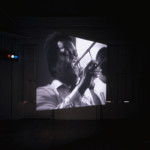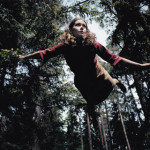By PHAEDRA SHANBAUM
Attending exhibitions of video or time-based new media art, can be a tedious and belaboring experience as these types of works tend to be curated inconsistently and installed poorly. The exhibition spaces are darkened (forget about trying to read the didactics), claustrophobic spaces with poor acoustics; and the viewer must squint, battle poorly hung or off kilter projectors, and trip over wires in order to properly view pieces than range from two to 25 minutes in length.
Time-based, or new media works, are complex oftentimes created through the use of custom made hardware and software in various stages of development. Effective curation and installation of new and time based media relies on the merger of traditional museum practice with new practices that respond to the varied nature of the medium.
The List Visual Arts Center at MIT takes all this into account in its impeccably installed and curated Sounding the Subject: Selections from the Pamela and Richard Kramlich Collection and the New Art Trust. Through the use of music, spoken word, ambient noise, and silence, the artists featured in this exhibition use the camera primarily as a means of recording private performances and incorporating sound “to destabilize assumptions of the self,” according to curators Daniel Birnbaum and Mectild Widrich. Drawn from the collections of Pamela and Richard Kramlich and the New Art Trust, Sounding the Subject features one major work each by Eija-Liisa Ahtila, Stan Douglas, David Hammons, Nam June Paik, and Pipilotti Rist.
While the content of the works differ, the underlying theme that emerges in the first three pieces in the exhibition is the artists’ usage of sound to convey mood. Pipilotti Rists’ I’m Not the Girl Who Misses Much features the artist wearing a low-cut black dress and dancing before the camera while loudly singing the words that make up the title of the piece. The colorful images are faint and blurred, and the sound is doctored, delayed, and detached from the images. The pans and cuts are jerky—zooming back and forth and occasionally shuddering. As the exaggerated movements of Rist’s stamping dance intensifies, a bright red blotch just below her heavily made-up lips becomes the focus of attention, and she becomes a crazy, hyper-sexualized caricature of herself. Throughout the entirety of this performance, Rist sings the first line of the Beatles’ Happiness is a Warm Gun, altering the words slightly, reclaiming them for herself and combining them with images of exaggerated references to stylistic clichés of MTV, fashion, and sexuality. The projection screen is sunk into the wall slightly, creating the illusion of a frame. This hint of a frame allows the viewer to make the leap that they are watching the piece on a television. The sound and structures frame and enhance the piece and its staged parody of popular culture.
The noisy and confused aspects of Rists’ early work is directly contrasted in the adjacent work in the exhibition, Nam June Paik’s silent and meditative work, TV Buddha. Through the merging of silence, video streaming and installation, TV Buddha successfully combines the worlds of performance, artistic practice, and musical composition, respectively. In this piece, the figure of Buddha contemplates an image of itself stuck in an infinite temporal loop. This version, created in 1989, features a statue of Buddha facing a video camera and television monitor. The Camera continuously videos the Buddha while the Buddha stares at the image of itself on the monitor produced by the video camera. The instantaneous playback, the ephemeral nature of the medium and the work’s placement in the exhibition give the silent Buddha’s performance a centered but narcissistic feel.
The centered and meditative feeling is all but lost once you enter the pitch black screening room of the last work in this grouping, Eija-Liisa Ahtla’s disconcerting depiction of a woman’s mental breakdown in The House/Talo. Created in 2002, this is the most recent piece on display in the exhibition. Projected onto three screens, The House/Talo, depicts a woman, Elisa, performing daily activities - arriving home, looking out the window, moving from one room to another, eating, sewing, etc -but who expresses through the use of a voiceover the disconnection and inconsistencies between what she is actually experiencing and what she is thinking. The concept, in which the idea of her self has lost coherence, is emphasized by the soundtrack, as sound penetrates places that visuals cannot. We hear the car engine humming after it is parked and noises of ships and trains in the living room of her isolated home. Elisa sews and hangs black curtains over her windows in order to “shut out the images,” but she can never escape the noises. "I think the living room of my house is breaking down," she says. "It can't keep things out anymore, can't preserve its own space." As she describes, and we view the symptoms of her mental breakdown, Elisa sews and hangs black curtains over her windows in order to “shut out the images,” but she can never escape the noises. In the eventual total darkness of the house her psychological meltdown seems all but complete. The doors and windows of Elisa’s house, mimic the set-up and gaps in between the three screens (painted green, blue and red - a new addition to the piece since it was purchased) emphasize the disconnect and act as entry points between reality and delusion but provide no solution to the problem.
The last two pieces in the exhibition utilize sound in a different way than the first three. Instead of using it to convey a mood, the remaining pieces explore the use of sound within a more musical context. The sound in both pieces reference aspects of popular music, which emphasizes and enhances the political and social messages buried within the works’ narratives. Filmed in video in 1995 , David Hammons’ Phat Free references elements of earlier street performances by himself through the use mundane experiences, which indirectly address issues concerning urban space, race, and social norms. In the first two minutes of Phat Free, we hear a metallic and melodic sound. It is only when an image finally appears that we realize what is producing the sound: Hammons kicking a metal bucket through an urban landscape at night. The bucket is kicked at walls, over grates, and across the sidewalks and streets of New York City while the camera films his musical performance from behind and at his side. The visuals are grainy and harken back to early video works that utilize close circuit cameras. The sound, episodic, creates a minimal soundtrack that never crescendos, but ends on a high note with Hammons kicking the bucket into his hands.
This jazz-like element of Hammons piece acts as an introduction to the next and final piece on display, Stan Douglas’ musical Hor-Champs, a double projection of a free jazz performance featuring Robert Iler and digital music pioneer George Lewis. Simultaneously projected on either side of one screen, Hor-Champs shows two separate sets of footage of the same performance, one, a finished and edited version emphasizing solo performances and the other, completely unditied, embodies the underlying political and social organization ideals of the rulelesness medium of free jazz. This idea is heightened through the composition played: Albert Ayler’s 1965 Spirits Rejoice, which incorporates parts of La Marseilles and The Star Spangled Banner.
- Pippilotti Rist, I’m Not The Girl Who Misses Much, 1986. Courtesy Electronic Arts Intermix (EAI), New York.
- Stan Douglas, Hors-champs, 1992, Courtesy of David Zwirner, New York
- Eija-Liisa Ahtila, The House, 2002, 14 min. Courtesy: Marian Goodman Gallery, New York
"Sounding the Subject" is on view through December 30th at the MIT List Visual Arts Center.
Images are courtesy of the List Visual Arts Center.







